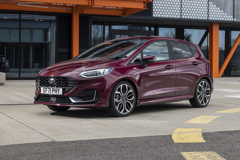Suzuki Swift Review 2024
Suzuki Swift At A Glance
The Suzuki Swift is now in its 40th year in the UK, and in this latest iteration is in an ideal position to make several thousand new friends. That, Suzuki says, is because the competition is dwindling in number, with several small hatchback rivals being discontinued or becoming electric cars only. Does it have what it takes to convert these potential buyers? Our Suzuki Swift review reveals all.
Their numbers may be on the decline, but there are still plenty of petrol-powered small cars out there – the budget-focused Dacia Sandero, for example, or the Hyundai i20. Or if you fancy a used model, there is no shortage of Ford Fiestas.
Smaller, shorter and lighter than most of its small hatchback contemporaries, the Suzuki Swift definitely sits at the value end of its class, especially when you factor in how much standard equipment there is.
This fourth-generation car is no head-turner; indeed, there a strong case for its predecessor being a better looking car. But Suzuki listens to its owners, which is why the rear door handle is back, no longer disguised within the rear pillar, and, presumably, there’s a generally more conservative appearance.
On board, though, things have become much more interesting. The new, two-tone design is a massive leap forward in terms of styling, even if all the finishes are still hard, scratchy plastic to the touch, and even if the cockpit is still awash with analogue dials and proper physical switchgear.
And there’s a new nine-inch audio display touch screen atop the dashboard which, though hardly the last word in technology, does the job perfectly well, though often rather slowly.
Thanks to steering wheel rake and reach adjustment a good driving position is easy to come by, although the seat may be too high for some. The seat itself is well bolstered and a good fit, although not the last word in comfort.
Rear seat space is, frankly, a bit tight for adults, but that’s par for the course in this class. And with just 265 litres of space below the parcel shelf, load capacity is limited, too.
There’s just one engine available; a new 1.2-litre three-cylinder mild hybrid petrol unit delivering 82PS and 112Nm of torque to the front wheels. It may be mated to either a five-speed manual gearbox or a CVT automatic. This is also the only small hatchback in the UK available with optional four-wheel drive, paired exclusively with the manual transmission.
This isn’t a quick car; in the Ultra manual variant we drove, 0-62mph is reached in 12.5 seconds, and the top speed is 103mph. What does impress however, is the WLTP combined fuel consumption figure of 64.2mpg, aided by the light weight of 984kg.
That is also a bonus when it comes to handling, and despite a lack of power, it’s still fun to drive. Ride quality, though, is not so impressive. The firm suspension required to elicit the flat(ish)-cornering agility tends to play havoc with occupants on anything but the smoothest of road surfaces.
You don’t expect a car this small to have the last word in ride quality, but many of the Suzuki Swift’s rivals offer a deal more cruising comfort.
In all, then, the Suzuki Swift makes just as compelling a case as it has always, doing things sufficiently differently to deter just as many as it attracts.
If, as the company suggests, there really is an increasingly large pool of potential customers looking for a small car with a traditional combustion engine, it’ll be interesting to see how many of them beat a path to a Suzuki dealership’s door.










 Outstanding fuel economy. Comprehensive standard equipment. Quite fun to drive.
Outstanding fuel economy. Comprehensive standard equipment. Quite fun to drive.
 Over-firm ride. Rear seat room under par. Limited loadspace.
Over-firm ride. Rear seat room under par. Limited loadspace.







 What is your car like to live with?
What is your car like to live with?


